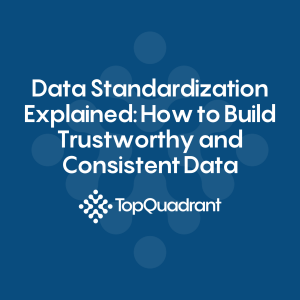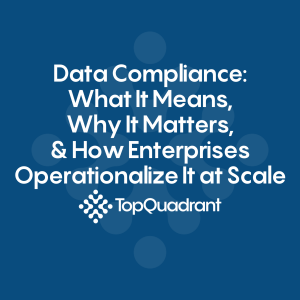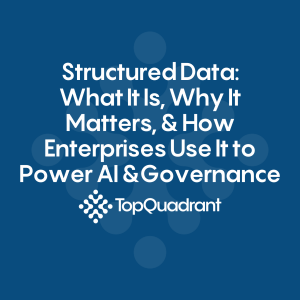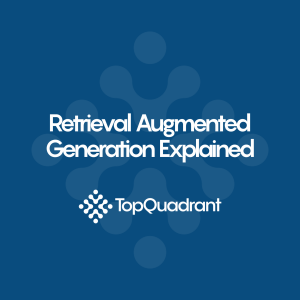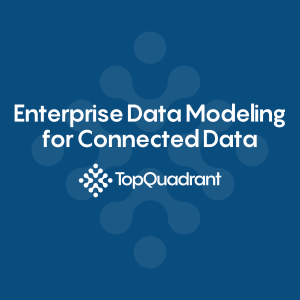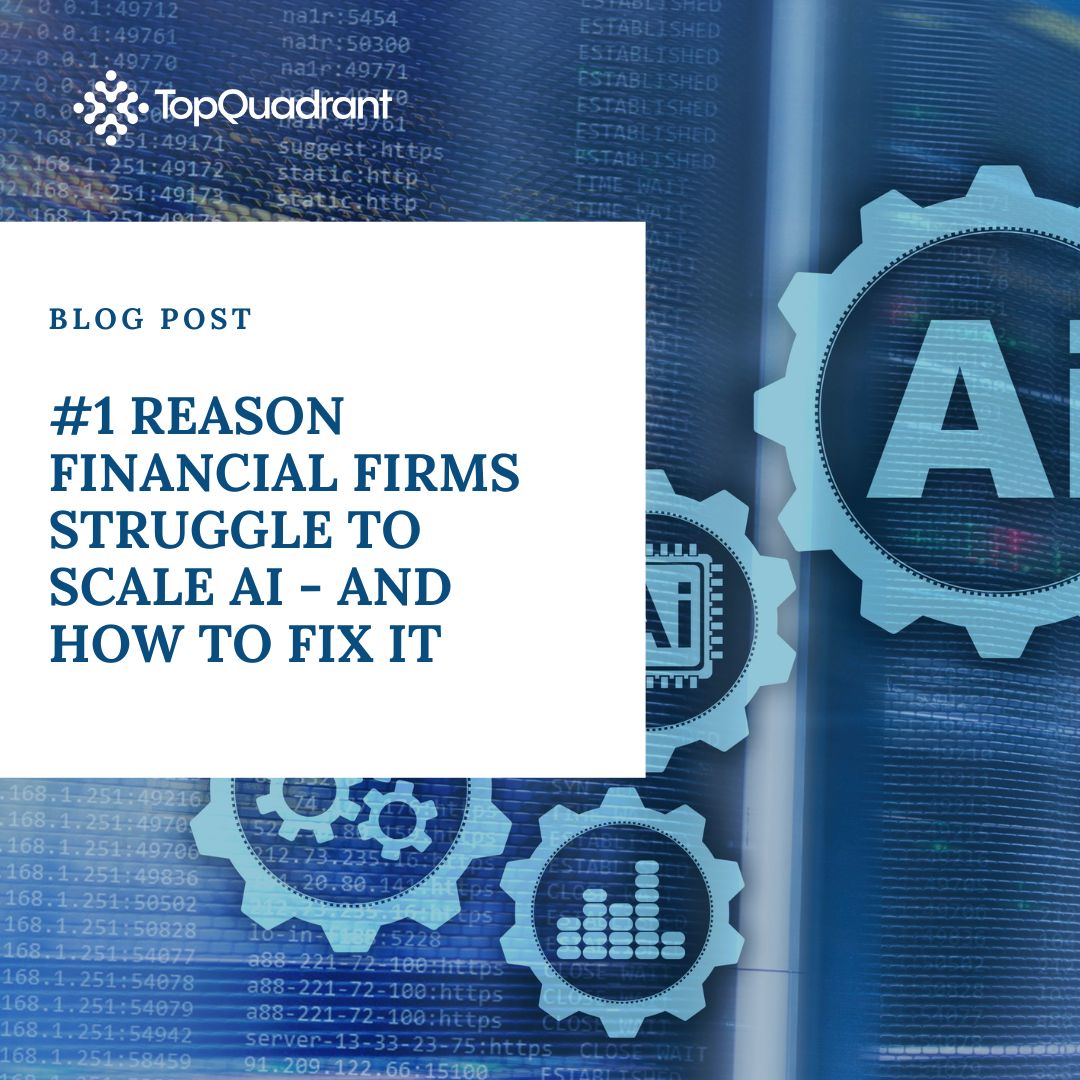Blog | Why Data Governance is Business-Critical in the Age of AI, Regulation, and Data Complexity

Modern enterprises are facing a convergence of pressures—growing regulatory obligations, accelerating AI adoption, and increasingly complex data environments that span formats, systems, and geographies. The common thread among these challenges? Data. Without robust data governance, organizations risk making decisions based on incomplete, inconsistent, or untrustworthy data.
TopQuadrant’s data governance platform provides a foundation of trust and transparency by embedding governance into the data fabric through knowledge graphs. This approach enables organizations to manage data more intelligently, ensure regulatory compliance, and scale AI initiatives with confidence.
What is Data Governance?
Data governance is the discipline of managing the availability, usability, integrity, and security of data throughout its lifecycle. It ensures that data is accurate, consistent, protected, and accessible to the right people at the right time. At its core, data governance provides a framework for defining ownership, setting policies, enforcing standards, and maintaining accountability across the organization.
Effective data governance aligns people, processes, and technology to deliver data that is trustworthy and actionable. It defines who can take what actions with which data, under what circumstances, and using what methods. This includes setting clear data ownership roles (such as stewards, custodians, and owners), establishing validation rules and access controls, and monitoring data quality over time.
For enterprise-scale organizations, the importance of governance only grows. As data volume and complexity increase, the risks of misalignment, duplication, and non-compliance become more severe. Without governance, different teams may define key business terms differently, making it difficult to compare results, make decisions, or meet regulatory obligations.
TopQuadrant enhances this foundation by leveraging knowledge graphs – semantic models that reveal relationships between data elements, metadata, policies, and users. By connecting data with meaning, TopQuadrant helps organizations automate governance processes, improve visibility, and support data discovery and reuse at scale.
Governance isn’t just about control – it’s about enabling the responsible use of data to drive innovation, reduce risk, and power AI systems that depend on high-quality, context-rich inputs.
Why is Data Governance Important for Enterprise-Scale Data Environments?
For organizations operating at scale, the consequences of poor data governance can be severe—ranging from compliance violations and reputational damage to failed AI initiatives and financial loss.
Data governance enables:
- Regulatory compliance: Frameworks like GDPR, IDMP, HIPAA, and Basel require traceability, audit trails, and policy enforcement.
- AI/ML readiness: Machine learning depends on clean, reliable, and well-documented data. Governance ensures that training datasets are trustworthy and explainable.
- Business agility: With clear policies and ownership, teams can make faster, data-driven decisions and adapt to change more effectively.
- Operational efficiency: Governance reduces duplication, manual rework, and inconsistent reporting by establishing a single source of truth.
Without strong governance, enterprises are left with fragmented data ecosystems, inconsistent terminology, and disconnected tools – leading to poor outcomes and limited scalability. By contrast, governed environments foster trust, compliance, and innovation.
What Challenges Does Data Governance Solve?
TopQuadrant helps enterprises overcome the most persistent challenges of managing data at scale. Siloed definitions and disconnected taxonomies lead to misalignment between teams and inconsistent reporting. Without a shared language, business units often duplicate efforts or misinterpret key terms.
Manual governance processes—often dependent on spreadsheets or outdated tools—introduce risk and are difficult to maintain across growing data ecosystems. This erodes data trust, as stakeholders struggle to trace where data came from, who owns it, or whether it’s accurate.
Compliance is another pressure point. Enterprises must be able to demonstrate data lineage, enforce policies, and generate audit trails with precision and transparency. In parallel, AI and machine learning initiatives face growing scrutiny: biased, incomplete, or poorly governed data can break models or introduce compliance risk.
TopQuadrant solves these issues by embedding governance into the enterprise data fabric. Using knowledge graphs, the platform provides semantic context, automated lineage, and a unified governance layer—empowering organizations with trusted, traceable data that’s ready for compliance, innovation, and AI.
Common Use Cases for Enterprise Data Governance
TopQuadrant supports a diverse set of data governance use cases:
- In life sciences, it enables IDMP compliance, submission readiness, and controlled vocabulary management.
- In financial services, it supports risk data aggregation, regulatory reporting, and lineage tracing.
- In media and publishing, it helps align metadata, manage content categorization, and improve search experiences.
- Across enterprise-wide AI/ML, it ensures training data readiness, model explainability, and regulatory auditability.
- It also enables enterprise-wide business glossaries and semantic search, helping teams find, connect, and understand data across silos.
What Makes a Strong Data Governance Framework?
Modern data governance goes beyond static metadata—it demands a semantic, scalable foundation. This includes rich metadata modeling that reflects relationships and context, not just labels. It also involves formal policies and validation rules (e.g., SHACL), clear stewardship roles, lineage tracing, and shared conceptual frameworks like ontologies and taxonomies.
Most importantly, governance must be collaborative. Business and technical users should be able to participate in defining, enforcing, and evolving governance practices. TopQuadrant delivers all of these capabilities within a knowledge graph-powered platform—ensuring scalability, adaptability, and alignment with enterprise goals.
Best Practices for Data Governance in Complex Enterprises
To succeed with enterprise-scale governance, organizations should:
- Start with high-impact, clearly defined use cases
- Use semantic models that bridge the gap between business and technical understanding
- Build cross-functional teams to promote ownership and accountability
- Automate validation, policy enforcement, and lineage tracking where possible
- Standardize on open, extensible frameworks like RDF, SHACL, SKOS, and OWL
- Promote governance as a value driver, not just a compliance requirement
These practices help organizations operationalize governance in a way that is strategic, sustainable, and scalable.
How to Select the Right Data Governance Platform?
When evaluating a data governance platform, it’s important to look for key capabilities that ensure both flexibility and long-term scalability. Native knowledge graph modeling is essential for capturing relationships and context, providing a foundation for intelligent, connected data. The platform should also support governance standards such as RDF and SHACL to enable interoperability and rule-based validation. Enterprise readiness is critical, including robust scalability, security, and role-based access control. To streamline governance activities, the solution should offer workflow automation and stewardship tools that support collaboration across teams. Seamless integration with data catalogs, ETL pipelines, and analytics platforms is also vital for ensuring governance extends across the full data lifecycle. Finally, a proven track record in regulated industries signals that the platform can meet high compliance and audit requirements.
TopQuadrant offers all this and more – designed specifically for complex, high-value data ecosystems.
FAQ: Data Governance and Knowledge Graphs
What is a data governance platform?
A data governance platform provides the tools and frameworks needed to manage data policies, lineage, quality, and compliance across an enterprise.
What is an AI-ready data foundation?
An AI-ready data foundation is a data ecosystem that provides clean, well-documented, semantically-rich data that can be reliably used by AI/ML systems.
How do knowledge graphs support governance?
Knowledge graphs model the relationships, definitions, and context needed to enforce governance at scale and enable semantic reasoning.
What’s the difference between metadata management and data governance?
Metadata management focuses on describing data, while governance defines the policies, roles, and accountability for managing the data.
How does TopQuadrant help with regulatory compliance?
TopQuarant helps with regulatory compliance by enabling automated lineage, semantic traceability, and policy validation—critical for audits and reporting.
From Governance to Intelligent Activation
Enterprises are no longer asking whether to govern their data, but how to do it intelligently and at scale. Knowledge graph-driven governance platforms like TopQuadrant’s deliver more than control: they deliver context, agility, and insight.
Data governance isn’t a checkbox, it’s the foundation for AI, compliance, and digital transformation. Ready to modernize your governance strategy? Schedule a demo, learn more about Data Governance, or Explore TopBraid EDG today.
-
Data Governance69
-
Vocabulary Management9
-
Knowledge Graphs44
-
Ontologies15
-
Data Fabric8
-
Metadata Management21
-
Business Glossaries6
-
Semantic Layer12
-
Reference Data Management7
-
Uncategorized2
-
Data Catalogs16
-
Datasets11
-
Taxonomies4
-
News5
-
Policy and Compliance6
-
Life Sciences6
-
Automated Operations6
-
Financial Services10
-
AI Readiness25
-
Podcasts1
